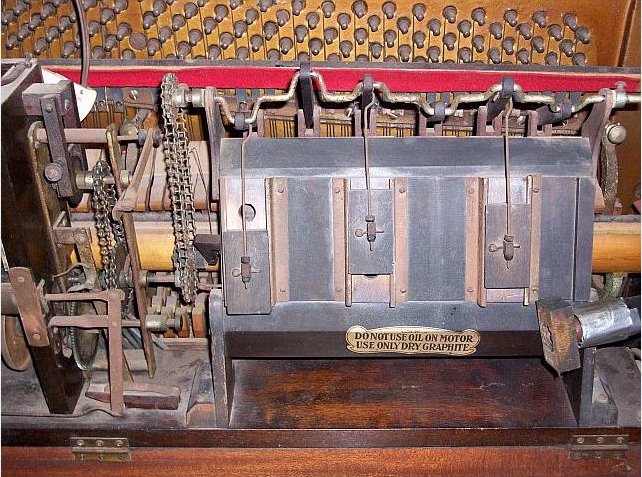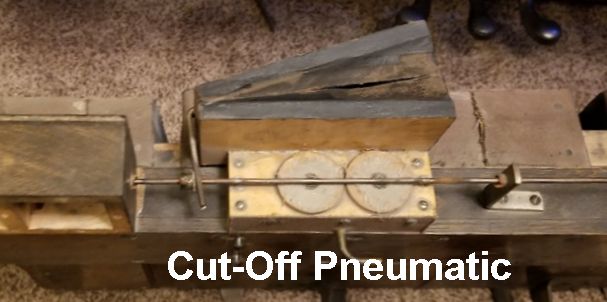
|

|

|

|

|

|
| Home | Manuals | Supplies | Search | Consult | Contact | Testing | Service |
Always a two-tier stack. The valve is significant and remained the same throughout all H. C. Bay actions. The valve was a molded black composition similar to the old piano roll spool ends. Since no other player action used a valve exactly like this, this is all that is needed for identification. If any automatic tracking device was used, it would be the friction-wheel or "fish-pole" type. The top tier had a side cover board to which all the rubber tracker bar tubing was connected. Alternate nipples, from the bottom of this board, went on to connect to elbows through the cloth patch on the front of the bottom tier. The tubing connection strip was with leather gasket and could be removed to expose the row of brass bleed cups between the gasket strips. However, by removing any one of the round head wood screws that opposed the bleed cups from the exterior, the bleed holes individually, could be cleaned. The pouches could be seen through the narrow opening exposed by the side cover strip, however the two wooden sections comprising the pouch board and the valve wells were glued together. Below is a valve and the nameplate used in the spoolbox. *An earlier type valve was used, but rarely found. This was the conventional wood disc faced with leather on both sides, and used a wooden fluted valve stem. The valve well was covered by individual glued on cardboard washers. Also, it has been found that H.C. Bay had an unusual air motor that consists of six side-by-side bellows and only three sliding valves. It has also been found that the system used a pneumatic cut-out valve instead of the more common mechanical sliding valve found in most player pianos. (see picture below) |



It would seem that the H. C. Bay player action made a late entry into the field about 1915. The patent dates displayed on the nameptate may have been for prestige or cover-up for this fact. The two earliest, 1899 and 1911 are Melville Clark patents concerning the adjustable tracker bar and the take-up spool. The 1911 patent was a far-out idea of B. K. Settergren, which was never even made use of. The simple construction of the H. C. Bay player offered nothing original, it was cheaply made, and widely used in inexpensive pianos. |
|
Since "Player-Care" is an internet business, I prefer that we correspond via E-Mail (click here to fill out the 'Request Form'). However, if I'm not in the middle of some other activity, you can reach me at 732-840-8787. But please understand that during the hours from 8AM-5PM EST (Mon-Sat), I'm generally quite busy. So, I probably won't answer the phone. If you get the answering machine, please leave a detailed message stating the reason for your call. Also, repeat your name and phone number clearly and distinctly. By necessity, I prioritize everything in my life. And, if you call and just leave your name and number, and ask me to call you back, it might be a day or two before I return your call. Why? Because I don't know why you want me to call and I might not be prepared to assist you in an effective and efficient manner. If you leave me an E-Mail address (which I prefer), spell it out phonetically. The more you do to help me, the more I can help you in return. Don't rush. You have four minutes to record your message. |
|
407 19th Ave, Brick, NJ, 08724 Phone Number 732-840-8787 (Voicemail Only, No Texts) |
